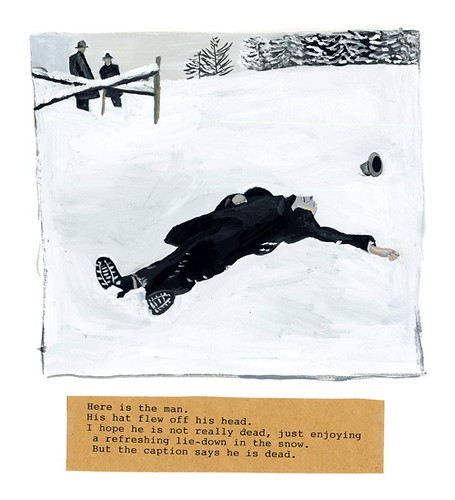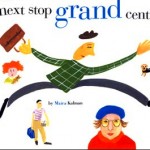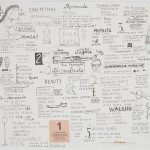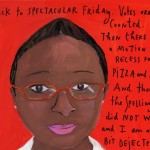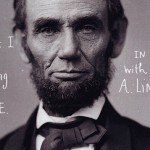
Maira Kalman (right) and Tracey Tannenbaum at the First Person Festival last month.
Maira Kalman spoke to a full house on Nov. 11, the last day of the First Person Festival, and while that was a while ago, I want to share the event. The slide show/conversation had much good humor and sparked happiness (including in yours truly) in a packed room. Kalman’s anecdotes were a lot of fun and she’s a great, comfortable speaker, and you can catch her in coversation Dec. 13 in New York at the Museum of Art and Design. See info at the bottom of this post.
The artist’s drawings which appeared in her New York Times blog are now a book, The Principles of Uncertainty. The hard cover book, published by Penguin, with 325 pages of richly colored illustrations is a perfect sketchbook-like size for Kalman’s confessional outpourings. Also, the artist-illustrator is a great example to young woman artists today showing how to interweave art and life and actually make some money from it! See amazon.com by the way for a good price on the book.
Kalman spoke with local arts reporter Tracey Tannenbaum who is a great questioner.
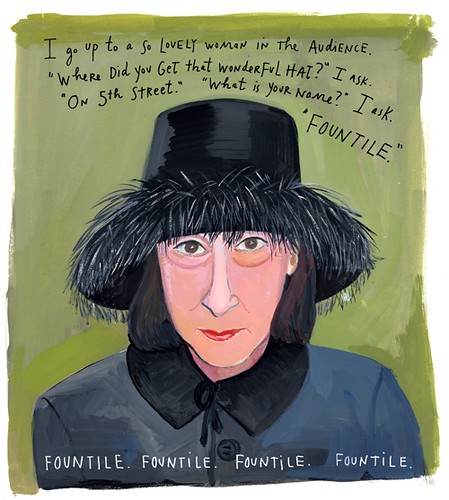
Kalman’s affinity for hats –and for people who she finds endlessly fascinating–comes up repeatedly in the blog/book.
The artist is a kind of grown-up wise child who draws in a style reminiscent of Florinne Stettheimer–naive yet sophisticated. Her painted people may not be academically-perfect but their shoes, hats, suits and hair will be styled to death, and overall the sense of brushy breathlessness is very engaging. And her colors are great.
Kalman roams the world like a spy in search of small oddities that appeal to her whimsical and humanist-focused nature. Unlike the child-spy Briony in Ian McEwan’s Atonement (two thumbs up for the the movie), whose spying and imaginative embroidering leads her into ethical bad behavior that directly harms many others in her sphere, Kalman’s spying, sometimes quite out in the open, is transformed into drawings and paintings that are highly moral essays on the importance of love, life, humor and generosity.
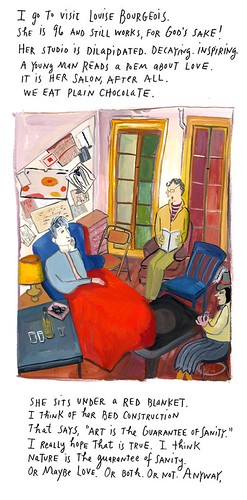
Because she is a documentarian as well as a whimsical thinker who tries to weave things together for you, she’s got some works, like this, based on places she’s been and people she’s spent time with, some of them famous, like here where’s she’s at Louise Bourgeoise’s salon.
Kalman takes photographs, and it’s from the pictures that her art grows. She doesn’t like to work from imagination, she says, but she loves to embroider imaginatively from her photos. She’s not training her lens on the world’s Eiffel Towers and Colisseum’s she’s looking at pigeons, the backs of people walking away from her, hats, cakes, boxes and string. The work is whimsy, part heart of darkness. She confessed she keeps busy to stave off thoughts of death.
The artist is a collector, but again, not of expected precious wonders. She collects sponges, empty boxes, whistles, egg slicers, fanciful candy, and flea market oddities like a box of Long Island moss, a complete collection that she now owns.
Here’s a few things she said that made everyone laugh or at least nod their head in agreement.
“The good news about my work is that I can wake up…read the obit page…and make work as a natural fluid part of my day.
“It’s not random. I don’t wander around like a crazy person…But I DO wander around like a crazy person…it’s just that I get paid for it.
Several people had influence on her:
Ludwig Bemelmans…the way he wove together high and low, sophistication and silliness. Lewis Carroll.
About her illustration of the Strunk and White grammar book, The Elements of Style.
“We were at a church sale on Cape Cod and I picked up Elements of Style (I escaped it in college). And I thought I’m going to illustrate this tome. I’m going to contact the Whites, so I contacted them and said I’m going to illustrate the book and they said “What do you mean?”
She wasn’t going to illustrate the points of grammar but the anecdotal examples that illustrate the grammar points.
Embroidery
She started sewing cliches mostly on napkins stolen from hotels “which is nice because I remember the excitement of stealing it…”
Her New York TImes Blog, The Principles of Uncertainty
I don’t like the word blog…it reminds me of blurt and barf. I call it an illustrated column.
She had a meeting with the NY Times. They said What do you want to do. She said I don’t know.
She began the blog (May 6, 2006) with the dodo bird, “which I like very much. The dodo didn’t make it.” (ie it’s extinct)
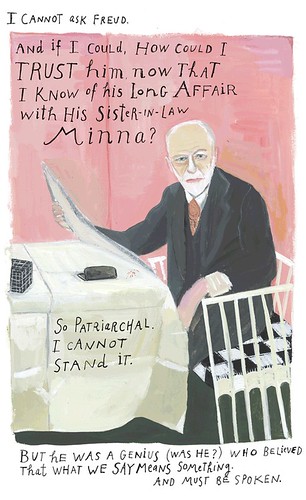
Freud, one of the pages in her stream of consciousness blog and book.
After that, the blog goes right to Spinoza, with whom she sympathizes for his excommunication and suffering for his beliefs. “He died and we have no more Spinoza, not even a stuffed Spinoza. But we have a stuffed Pavlov’s dog…in Moscow.”
Which led her to Stalin, Freud, Russia and her mother.
“We came to America in 1954. It was an optimistic time. We always maintained Israeli identity but fell in love with it here.
I asked people to make a map of the US. My mother was a very irreverent woman…
She shows her mother’s map (which is in the book as a fold-out/tear-out poster.
The Rubber Band Society
The Rubber Band Society was begun with Alex Melamid (he’s not with Komar anymore).
She was having lunch with Melamid and he dumped a pile of rubber bands from his pocket on the table. She said I LOVE rubber bands. He said I LOVE rubber bands. They formed the society and put up some notices.
“We didn’t do anything and finally people kept coming…250 people! And it wasn’t so much fun.
The flow of happiness and unhappiness
The February New Yorker cover was the Misery Day Parade…”It’s a horrible month”
In February I painted a lot of sad story paintings. Ruminating on lying and telling the truth. Why can’t people tell the truth?
Story about meeting a monk who had a pamphlet about inner peace. “Would my family drive him nuts? In my house there was zero inner peace. It’s good to have a sense of humor because nothing was funny. My parents didn’t talk to each other but they were very social. She tells a story about parties at her house and how her mother would get a mocha creme cake from Mother’s Bakery in Riverside, NY.
So for an event surrounding Principles of Uncertainty at the New York Public Library she ordered 30 mocha creme cakes from Mother’s Bakery in Riverside NY.
“The really big questions in my life were answered by “let’s bake a cake and eat it.”
TRACEY TANNENBAUM asks a question about doesnt she feel like she’s exposing herself?
MAIRA KALMAN I’m not really exposing myself. I’m giving you the tip of the iceberg.
TT How did the blog become a book?
MK An editor at Penguin said “There is a book here.” I was really happy
TT Asks a question about her hat and other obsessions
MK If anybody’s a collector you’re always saying why do I need this or this. Everything in the book makes me happy. It’s not about being cynical….Things bring me great joy–I see a fez and I’m giddy for a week. Maybe (these things) tell me something about life.
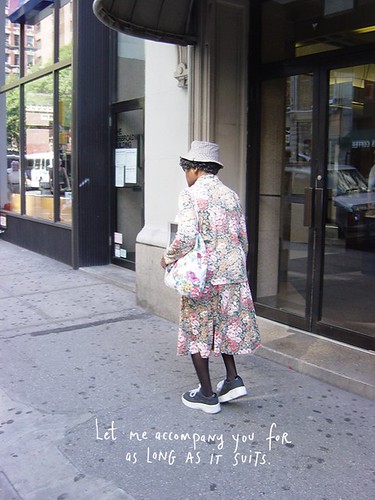
One month on the blog is a photo-month with pictures taken by the artist as she follows people around Manhattan or wherever she is.
TT You follow old people around?
MK Sometimes people do turn around and say don’t take my picture but I’m a benign presence. I’m not threatening. My connection, my life is following people on the street. Sometimes I have a sandwich with them and then that’s it.
TT How do you edit yourself?
mk I’m walking around taking pictures and I’m having dreams of a woman with red waterfall hair….It’s not intellectual, I’m trying not to think… I walk slowly. I bought big boots in England. It slows me down…slows time down.
TT Are these things distractions to keep you from thoughts of death?
MK Like the Marx Brothers, you need extraordinary distractions not to stay in the depths of what’s going on and to say, by the way, there’s a comedy going on around the corner.
TT What were you like as a kid?
MK My mother never stopped me from dreaming. My private space was never intruded on. There was no call back to reality. I have a whimsical nature and it stayed. I never had to have a normal job (well I was a waitress–that’s normal). I learned I have no idea what’s going on …i don’t know anything.
TT Asks question about the July war between Israel and Lebanon and how she went to israel for a wedding.
MK You can’t cancel good things in bad times. We went to Israel and there was a war and there was a wedding. The war stopped and the wedding’s on.
March, 2006, on the blog
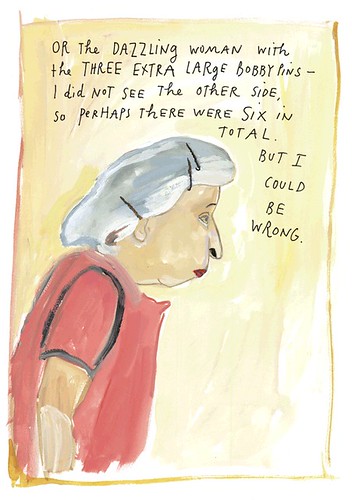
Kalman’s fascination with old people and with bobby pins is seen here.
She shows a series of images…There’s a stream of consciousness mix of topics: Freud, Wittgenstein the Strand bookstore. “I was told to read Walter Benjamin’s book of childhood. He killed himself”…An old woman with bobby pins…”Look at that beautiful woman with those beautiful bobby pins.” Robert Polidori’s photo..”I did a painting. It’s what I want my set for my opera to look like (she wants to turn Principles of Uncertainty into an opera).
“There are no limits. I can leap into the world of opera. I have some other plans.”
Service
She’s in the service portion of her life. She wants to be a maid for the Duchess of Windsor “I’m an incredible cleaner and the Duchess will like it.” She wants to work for Pina Bausch and for several others.
She ends with a slide that says Keep Calm and Carry On. It’s British, from the war poster.
Audience Q: Do you write the words on the works while you’re painting?
MK No I wrote on a typewriter and add the words at end.
Q What writers do you read?
MK Gertrude Stein…not that I’m comparing. She comes to mind first. She was writing in pictures. I would never want to write without pictures…I’m not a writer. Lewis Carroll, Charlotte Soloman. I go back and forth between writing and painting.
Q Does corrugated cardboard speak to you too?” (like rubber bands)
MK Yes it speaks to me very much
Q Do you paint from memory?
MK It’s very hard to paint from memory. I like to paint from photos. I would like to do more of remembering and painting but love photography and I love to combine them.
Q What does your house look like?
MK Clean, modernist, minimal, nothing on the walls.
Q Where do you keep all your collections of rubber bands etc
MKIn the studio. I visit them. My mosses (collection of mosses) became the endpapers of the book

“New Yorkistan”
New Yorker Cover
December 10, 2001
by Maira Kalman and Rick Meyerowitz
Q How does the New Yorker commission its covers?
MK There’s a stable company of 40-50 illustrators who get a printout of the subjects by week. Once you are asked you are part of the group. A lot of them are politically aware…Sometimes you get asked to do something. The New Yorkistan cover (a collaboration between Kalman and Rick Meyerowitz)…we sent it in as inside work and they wanted it on the cover…We had 3 times as many names as what we used. (the piece went back and forth with the editors before it was finished). (see page of all Kalman’s covers for the New Yorker).
Q Do you show your drawings?
MK Yes right now they’re at Julie Saul Gallery. (ed note: the show is now over)
Q Question about obstacles…
MK I wonder if what I’m saying has any value…that probably enters into the work. There are days when you feel brave and you plow ahead and days you feel (bad but you must)…keep on working. Grind on and work and try to find the glorious moments on the other side of panic.
Q Question about the Wittgenstein quotes you use.
MK Oh, I don’t know anything about Wittgenstein! Except his last words “Tell them I had a good life.” I don’t understand his tracts but I love the sentences.
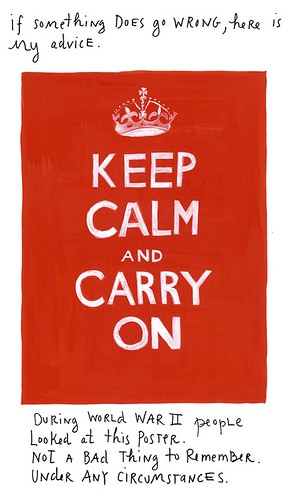
Kalman is a charming conversationalist and she’s speaking in New York Dec. 13 in a FREE program (with pay as you wish museum admission) in conjunction with the exhibit “Pricked: Extreme Embroidery” at the Museum of Arts and Design. If you’re up there, don’t miss it.
In conversation: Maira Kalman and Chee Pearlman
Museum of Arts and Design
40 W. 53rd Street
Thursday December 13, 6:30 – 8:00
NOTE: Thursday is pay-what-you-wish night.
And here’s a Maira Kalman TEDTalks video. Thanks, Tyler Paint for bringing it to our attention.


